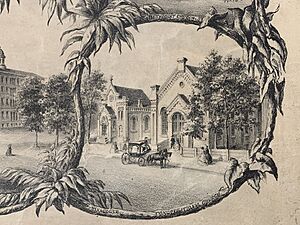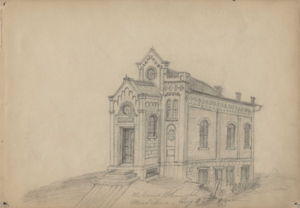Gates of Heaven Synagogue facts for kids
Quick facts for kids Gates of Heaven Synagogue |
|
|---|---|

The former synagogue building, in 2012
|
|
| Religion | |
| Affiliation | Judaism (former) |
| Ecclesiastical or organizational status |
|
| Status |
|
| Location | |
| Location | 302 East Gorham Street, Madison, Wisconsin |
| Country | United States |
| Architecture | |
| Architect(s) | August Kutzbock |
| Architectural style | Romanesque Revival |
| Date established | 1856 (as a congregation) |
| Completed | 1863 |
The Gates of Heaven Synagogue, also known as the Old Synagogue, is a very old and special building in Madison, Wisconsin. It was designed by an architect named August Kutzbock and built in 1863. It was first used by a Jewish community called the Gates of Heaven congregation.
This group of 17 German-speaking Jewish families used the building for their services. However, they faced money problems and had to rent out the building starting in 1879. They finally sold it in 1916. After that, the synagogue was used for many different things, like a dentist's office, a place for funerals, and even an office for a US Congressman.
In 1970, the building was almost torn down! But people in the community worked hard to save it. They raised money to move the synagogue to a new spot. In July 1971, the building was carefully moved to James Madison Park. Many people and groups helped with this big effort.
The Gates of Heaven Synagogue is one of the oldest synagogues in the United States. It was added to the National Register of Historic Places on December 29, 1970. Today, it's a popular place for events like weddings. It also still hosts Jewish ceremonies and special holiday services.
Contents
The Synagogue's Early Days
The first Jewish people to live in Madison were immigrants from Germany. They started arriving in the 1850s. In March 1856, seventeen Jewish families in Madison created their own synagogue. This was the second Jewish community in Wisconsin.
The group was first called Ahavath Achim, which means "Brother Love" in Hebrew. Later, they changed their name to Shaare Shomaim, meaning "Gates of Heaven". This synagogue followed the Reform movement. In 1859, the group bought land in Forest Hill Cemetery to use as a Jewish burial ground.
Before 1861, the synagogue met in the home of Samuel Klauber. He was the group's treasurer and the first Jewish person to live in Madison. In 1862, they decided to build their own special building. They chose August Kutzbock as their architect. He was a German immigrant who had designed many buildings in Madison, including the first city hall.
In October 1862, the congregation bought land at 214 West Washington Avenue. It was right next to another church. The foundation of the Gates of Heaven Synagogue was finished by April 10, 1863. The building was fully completed and officially opened on September 5 by a rabbi from Milwaukee. Important people like the Governor of Wisconsin and the Mayor of Madison attended the opening. Building the synagogue cost about $3000 back then. After Abraham Lincoln was assassinated in 1865, the Wisconsin Legislature held a memorial service at the Gates of Heaven synagogue.
The Gates of Heaven congregation never had more than twenty families. They also didn't have a formally trained rabbi for long. Joseph M. Thuringer, a brother of one of the members, came from Germany to serve as their rabbi. The group's numbers started to shrink in the 1870s as families left Madison. By 1878, only six members remained.
In 1879, the congregation rented the building to other groups. These included the First Unitarian Society of Madison, the Women's Christian Temperance Union, the First Church of Christ, Scientist, and the English Lutheran Church. The Jewish congregation sold the synagogue in 1916. They gave $1,500 to the city to help take care of the Jewish graves in Forest Hill Cemetery forever. The rest of the money from the sale went to different charities. The congregation's Torah scroll was given to another Jewish group in Madison. The Gates of Heaven congregation held its last meeting in 1922. They had been meeting in members' homes for many years.
After 1916, the synagogue building was bought by Arthur and George Gil. They used it as a funeral home until 1930. Then, it became a hotel, a warehouse for government papers during World War II, a church, a dentist's office, a vet clinic, and finally, an office for a US politician.
Saving the Synagogue from Being Torn Down
By 1970, the Gates of Heaven synagogue was known as the Old Synagogue. It was owned by a company that planned to tear it down to build something new. On July 20, 1970, they got permission to demolish it. Manfred Swarsensky, a rabbi from a nearby synagogue, felt sad that it might be lost.
Norton Stoler, a local person, heard about this and asked the company if the synagogue could be moved instead. On July 23, the company agreed to wait six months. This gave people time to raise money and plan the move. It was estimated to cost between $20,000 and $100,000.
To save the synagogue, Norton and Lois Stoler started the Gates of Heaven Synagogue Preservation Fund in September. They led the fundraising efforts. Many people and groups helped. They raised over $15,000 in cash and received services and materials worth at least $13,500. The US Department of Housing and Urban Development also gave a large grant of $29,500 in May 1971. Other donors included the Madison Fire Department and Oscar Mayer.
On December 17, 1970, the synagogue was nominated to be on the National Register of Historic Places (NRHP). It was approved and added to the Register on December 29. This helped protect the building.
On January 6, 1971, the Madison City Park Commission agreed to move the synagogue to James Madison Park. The company that owned the land wanted the synagogue moved by May 1. They had sold the land to another company that planned to build a tall office building. The new company extended the deadline to July 10.
Even though many people supported saving the synagogue, some were against it. One city council member called the synagogue a "junk pile" and a "waste of taxpayers' money." But in the end, the City Council approved the move.
The synagogue was placed on 96 wheels by July 13. The move was delayed a few times because of concerns about the building's safety. Finally, on July 16, 1971, the synagogue was rolled through downtown Madison. It was pulled by two large military vehicles and a hoist truck. The move took over 9 hours, from 10 AM to 7:20 PM!
Bringing the Synagogue Back to Life
After the move to James Madison Park in 1971, a local company helped restore the Gates of Heaven. They rebuilt the choir loft, which had been taken out years before. Another synagogue in Milwaukee donated a beautiful, hand-carved Torah ark from 1858. This ark was fixed up and changed to fit inside the Gates of Heaven.
Workers found old paintings on the walls and floral designs on the ceiling. But there wasn't enough money to restore them all. The outside of the building was repaired to protect the original sandstone. The lower floor was restored with money from a local committee and named Klauber Hall. The Gates of Heaven Preservation Committee worked on the upper level.
The first wedding in the synagogue in over 100 years happened on August 5, 1972, while work was still going on. On August 11, 1996, people celebrated the 25th anniversary of the synagogue's move and restoration. Over $150,000 had been spent on fixing up the building by then. Another restoration project happened in 2021. This included replacing windows, refinishing the floor, and repairing the stone walls.
How the Synagogue is Used Today
The Gates of Heaven Synagogue is owned and cared for by the Madison Parks Department. It's a very popular place for weddings and other events. It also still hosts special Jewish holiday celebrations and other ceremonies. A diplomat named Hannah Rosenthal has led the High Holy Day services since the early 1980s, often with musician Ben Sidran.
The synagogue has also hosted other events, like winter solstice celebrations. It even serves as a place where people can go to vote.
Unfortunately, the synagogue has sometimes been the target of hateful acts. In September 2017, hateful messages were found spray-painted near the synagogue. In November 2023, a group marched through downtown Madison, stopping at the State Capitol and Gates of Heaven. They shouted mean words and threats at people nearby.
Building Style and Location
The Gates of Heaven Synagogue is located in James Madison Park in Madison, Wisconsin, at 302 E. Gorham St. Experts describe the synagogue's style as Romanesque Revival style architecture. This style often uses round arches and strong, simple shapes.
The building is about 28 feet wide and 51 feet long. It is made from sandstone and brick. The front of the building and the basement walls are made of sandstone. The other walls are made of brick. The front of the building has a castle-like top and a round window. A small entrance area in the middle matches the shape of the main front.
The sides of the synagogue are divided into three sections, each with a window. A decorative band of Greek crosses runs along the top of the side walls. There are also chimneys on the roof. No one knows exactly what the inside looked like originally. But in 1971, people found that the ceiling was painted blue with silver stars. The Torah ark, which dates back to 1858, is made of dark wood called black walnut.
See also





